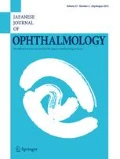Abstract
Purpose
The purpose of this study was to compare the efficiency of conventional screening and of the Spot™ Vision Screener (SVS)-based screening in detecting potential cases of amblyopia during the Visual examination in Three-Year-Old Health Screening Program (VTYOS), that need to be referred for comprehensive examination.
Study Design
Population-based cross-sectional study
Methods
This study introduced the SVS-based test to the VTYOS (which includes primary, secondary, and comprehensive examinations) of Sagae, Yamagata Prefecture, Japan. Children aged 3 years 6 months scheduled to undergo the secondary examination were subjected to both the SVS-based (evaluation of refractive error and eye alignment) and conventional screening test (questionnaire and visual acuity evaluation). Success rates, proportion of children who needed a comprehensive examination, rates of actual comprehensive examinations, and positive predictive value were determined and compared between conventional screening and SVS-based screening.
Results
There were 294 participants; the rate of success of SVS-based screening (99.7%) was higher than conventional screening (89.5%, p < 0.01). The proportion of participants found to need a comprehensive examination according to SVS-based findings (7.5%) was lower than that according to conventional screening-based findings (23.5%, p < 0.01). The positive predictive value of the SVS-based screening test (75.0%) was higher than that of the conventional screening test (31.6%, p < 0.01). SVS-based screening detected 2 cases of amblyopia in 225 cases that passed conventional screening.
Conclusion
The VTYOS should ideally add SVS-based screening to conventional screening.


Similar content being viewed by others
References
Chia A, Lin X, Dirani M, Gazzard G, Ramamurthy D, Quah BL, et al. Risk factors for strabismus and amblyopia in young Singapore Chinese children. Ophthalmic Epidemiol. 2013;20:138–47.
McKean-Cowdin R, Cotter SA, Tarczy-Hornoch K, Wen G, Kim J, Borchert M, et al. Prevalence of amblyopia or strabismus in Asian and non-Hispanic white preschool children: multi-ethnic pediatric eye disease study. Ophthalmology. 2013;120:2117–24.
Xiao O, Morgan IG, Ellwein LB, He M. Prevalence of amblyopia in school-aged children and variations by age, gender, and ethnicity in a multi-country refractive error study. Ophthalmology. 2015;122:1924–31.
Japan Ophthalmologist Association Public Health Department. The report of the visual test of the three-year-old health screening program (VI) in 2016. J JpnOphthalmolAssoc. 2018;89:171–6 (In Japanese).
Maruo T, Kanda K, Kubota N, Kozaki M, Suga J, Miyyamoto K. Guidelines for vision testing in health-check program for three-year-old children. Jpn Rev ClinOphthalmol. 1993;87:303–7 (in Japanese).
Donahue SP, Arthur B, Neely DE, Arnold RW, Silbert D, Ruben JB. Guidelines for automated preschool vision screening: a 10-year, evidence-based update. J AAPOS. 2013;17:4–8.
Peterseim MM, Papa CE, Wilson ME, Davidson JD, Shtessel M, Husain M, et al. The effectiveness of the Spot Vision Screener in detecting amblyopia risk factors. J AAPOS. 2014;18:539–54.
Tatara S, Ishii M, Ubukata H, Mizuno N, Ogasawara A, Oishi S, et al. Comparison of refractive errors measured by SpotTM Vision Screener at a health checkup for three-year-old children with those by a table-mounted auto ref-keratometer in a medical institution. JpnOrthopt J. 2018;47:141–6 (in Japanese).
Noda S, Oku M, Akayama S, Kanetsuki S, Notsu M, Kawata T, et al. The results of 3-year-old children’s visual screening over the past 11 years in Matsue City. Folia JpnOphthalmolClin. 2020;13:357–60 (in Japanese).
Suzuki M, Hikin M, Sato C, Matsuno N, Saito A, Mori T, et al. Experience of using SpotTM Vision Screener in a health checkup for 3-year-olds. JpnOrthopt J. 2017;46:147–53 (in Japanese).
Garry AG, Donahue SP. Validation of spot screening device for amblyopia risk factors. J AAPOS. 2014;5:476–80.
American Academy of Ophthalmology Pediatric Ophthalmology/Strabismus Panel. Preferred practice pattern guidelines. In: Amblyopia. American Academy of Ophthalmology. 2017. https://www.aao.org/preferred-practice-pattern/amblyopia-ppp-2017. Accessed 6 July 2020.
Kanda T, Yamaguchi N, Kawase Y. Visual acuity testing for three- and four-year-old children in nursery schools. Jpn Rev ClinOphthalmol. 1993;87:288–96 (in Japanese).
Ministry of Health, Labour and Welfare Equal Employment Opportunity Division and Child and Family Policy Bureau, Business communication: About the implementation of Visual Acuity test in the Three-Year-Old Health Screening Program. April 2017 (in Japanese).
Tatara S, Maeda F, Mizuno N, Noguchi A, Yaoeda K, Abe H. Refraction and pupil diameter in 3-year- and 1-month-old children as measured by Spot Vision Screener. Sci Rep. 2019;30:15622.
Modest JR, Majzoub KM, Moore B, Bhambhani V, McLaughlin SR, Vernacchio L. Implementation of instrument-based vision screening for preschool-age children in primary care. Pediatrics. 2017;140:e20163745.
Hayashi S, Nishina S, Mori T, Shimizu F, Nagumo M, Usui C, et al. The effects of refraction test in vision screening for 3-year-old children in Japan: a systematic review. Folia JpnOphthalmolClin. 2019;12:373–7 (in Japanese).
Matsuo T, Matsuo C, Kio K, Ichiba N, Matsuoka H. Is refraction with a hand-held autorefractometer useful in addition to visual acuity testing and questionnaires in preschool vision screening at 3.5 years in Japan? Acta Med Okayama. 2009;63:195–202.
Acknowledgements
This study received a grant from Pleotropic research of effective health checkups of infants and toddlers, based on the epidemiology of illness [17gk0110008h0003] and Yamagata Medical Association. In addition, we thank Sagae-shi Yamagata and Yamagata Ophthalmologist Association for cooperating heartily with this study. We would like to thank Editage (https://www.editage.com) for English language editing.
Author information
Authors and Affiliations
Corresponding author
Ethics declarations
Conflicts of interest
S. Hayashi, Honorarium for Lecturing, Advisory Board fee (Welch Allyn); I. Suzuki, None; A. Inamura, None; Y. Iino, None; K. Nishituka, Honorarium for Lecturing (Santen, RE Medical, ZEISS, Alcon, Novartis, Kowa, Johnson & Johnson, Senju, Sanwa Kagaku Kenkyusho, HOYA); S. Nishina, None; H. Yamashita, Grant (Senju, Alcon, Trustmedical, Atsuzawa, AMO), Grant, Honorarium for Lecturing (Santen), Grant, Honorarium for Chair, Advisory Board fee (Novartis).
Additional information
Publisher's Note
Springer Nature remains neutral with regard to jurisdictional claims in published maps and institutional affiliations.
Corresponding Author: Shion Hayashi
About this article
Cite this article
Hayashi, S., Suzuki, I., Inamura, A. et al. Effectiveness of the Spot Vision Screener in screening 3-year-old children with potential amblyopia in Japan. Jpn J Ophthalmol 65, 537–545 (2021). https://doi.org/10.1007/s10384-021-00823-x
Received:
Accepted:
Published:
Issue Date:
DOI: https://doi.org/10.1007/s10384-021-00823-x




